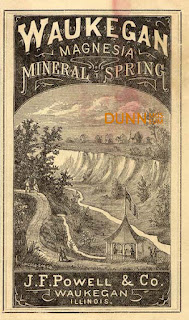There has been a tradition of brewing in Lake County since 1851.
In that year, Antoni Schieb, George Brownwell and Fredrich Hangebrauch purchased an acre of land along the Plank Road (Belvidere Street) in Waukegan to start a brewery. Schieb's Brewery was in operation for one year, when it sold the land and improvements to Charles Scoffin of Racine, Wisconsin. At the time, Scoffin was a co-owner of the Gnadt and Green City Brewery of Racine. Like its predecessor, Waukegan's Scoffin and Green Brewery lasted only one year.
Portrait of William Besley (1808-1897) by J. Derome, circa 1887. Besley founded the Besley Brewing Company in Waukegan in 1853. Dunn Museum 62.3.8
The run of bad luck ended when William Besley purchased the brewery. Besley (1808-1897) was born in Berkshire County, England where he learned the maltster's trade. He immigrated to Oakland County, Michigan in 1835, where he was a hotelier and worked as a maltster for a brewery.
In 1853, he came to Waukegan with the opportunity to purchase his own brewery. Besley enlarged the small, Scoffin and Green Brewery, and incorporated it as Besley's Waukegan Brewery. His sons would eventually join him in the business.
By the mid-1860s, the brewery's ales and porters had become so popular that more buildings were needed. Besley purchased land at Lake and Utica Streets along the Waukegan River, and contructed an ice house, malt mill, hop jack, storage cooler, barrel storage, cooper's building and main office.
Original location of the Besley Brewery, Belvidere Street, Waukegan. View circa 1880. Dunn Museum.
The original brewery on Belvidere Street was converted into a bottling house. Federal Law prohibited the brewing and bottling processes to be done in the same building. William Besley is shown in the photograph (above) in his carriage in front of the brewery on Belvidere Street. He was known for always having a white horse.
In addition to their porter and ales, the Brewery's yeast was popular with locals. Pails of yeast could be purchased for pennies at local stores to make buckwheat pancakes and baked goods.
Advertisement for Besley Brewery's "Good Yeast" available at Cory & Son's Store in Waukegan. Waukegan Weekly Gazette, December 15, 1855.
Besley's Home Brew bottle from 1908. Dunn Museum 70.109.11.
The thick plaster adhering to the bottle (above) suggests it was found inside a wall. This may be evidence of the long tradition of sealing beer bottles in the walls of new homes.
In 1871, the brewery opened an office in Chicago, indicating that the sale of Besley's brew reached beyond Lake County.
Besley Brewery on Lake and S. Utica Street, Waukegan, 1887. Dunn Museum.
A new brick brewery was constructed in 1887 at the Lake and Utica Streets site. When it was built, the building's construction date was on the facade, but later the date was changed to 1853 to reflect the year Besley began brewing in the city.
The brewery used water from Waukegan's springs, which it claimed contributed to the popular taste and gave the beverage curative properties. Local doctor, A.O. Wright wrote the brewery stating that "the nutritive qualities of the ale and porter... established for them a high place among the therapeutic agents of the day."
Besley Brewery advertisement, circa 1904. "Half & Half" was a mixture of porter and "beer" (lager). Poster of this ad is available for purchase through the Dunn Museum's Gift Shop.
Besley also brewed beer. There is some evidence that the transition to brewing more beer occurred at the end of the 19th century with a change in immigration patterns. By the late 1800s, heavy industry along Waukegan's lakefront brought immigrants from Czechoslovakia, Italy and Germany, who preferred beer.
William Besley died in 1897. His health declined after slipping on the street and fracturing a hip. His sons continued managing the brewery after his death.
In 1905, Besley's grandson, Frank Besley, enrolled in the Seibel Institute of Technology in Chicago where he learned to use adjuncts in the brewery process. Previously, the brewery had prided itself on using the "choicest barley" and "best hops," but a shortage of barley in the 1880s forced brewers to adapt.
Page from Frank Besley's Seibel Institute notebook, 1905. Dunn Museum 62.8.39.
The brewery then made costly changes to remain competitive, but it was at the time when many Midwest towns were voting for temperance. Years before Prohibition went into effect in 1920, communities voted to go dry.
Photo postcard of William Lux (1889-1959), teamster for Besley Brewery with delivery wagon, circa 1906. Dunn Museum 2004.6.3
The Temperance Movement effected the distribution and sales of alcohol throughout the region. It forced brewers to bypass dry towns, making delivery more costly and complicated.
About 1912, the Besleys sold the brewery to Thomas Snelling and other investors, who continued the operation. The real shock came in 1916, when pressure from temperance was just too much for the business. That spring Waukegan citizens, including women who had recently gotten the vote, voted for the town to go "dry." According to the Waukegan Daily Sun, the brewery could not operate "in a territory where it cannot sell its own product." Customers were shocked to read the headlines: "Besley Brewery is to Quit."
There would not be another brewery in Lake County until 1942 when the Zeman Brewing Company opened in Gilmer. It remained in business until 1964 when a tornado destroyed the building.
The county's first brewpub, Mickey Finn's, opened in Libertyville in 1993.















